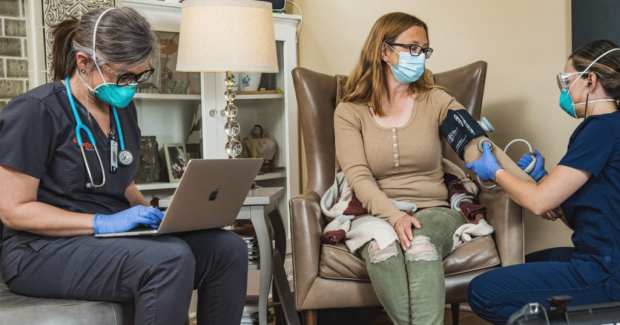The Doctor Will See You Now: At Home

Thanks to rapidly advancing technology, our homes are becoming much more of a commerce command center than a simple living space. Companies like Roku and Netflix have turned them into mini-movie theaters. Meal delivery services like Green Chef have turned them into intimate restaurants. And the endless eCommerce offerings have turned them into shopping malls. Riding this wave of home-as-everything is DispatchHealth, a company that brings the same services available in emergency rooms to patient’s homes, effectively turning them into one-patient hospital rooms.
PYMNTS spoke with DispatchHealth’s Founder and CEO Mark Prather, who told us that the company had just raised $200 million in a Series D funding round, which echoes the general trend of support for mobile medicine concepts. The company is now opening in a new market every three to four weeks and plans to be operating in at least 50 markets by the end of the year.
Its success isn’t surprising, seeing that the benefits of the service ripple out in all directions.
The number one recipients of these benefits are the patients that are at the heart of the platform. DispatchHealth arrives at their doors with everything from gastrostomy tubes to EKG and ultrasound equipment. Thanks to a new partnership, soon, mobile X-rays will also be available through the service.
Not only do patients get to take advantage of the convenience of having a mobile urgent care center arrive on their doorsteps when they have the need, using DispatchHealth keeps them out of facilities where they could contract viruses COVID-19 or the flu. Additionally, once the acute care is rendered, DispatchHealth can provide follow-up care amounting to in-home hospitalization.
Beyond the convenience of this, Prather said that research points to the fact that clinical outcomes actually improve when patients can be taken care of at home. He says his service has reduced hospital readmissions from 20 percent to 4 percent by caring for a patient for a full 30 days after an episode.
Such care might seem expensive, but fees are kept low thanks to DispatchHealth’s partnerships with major insurance companies, Medicare and Medicaid. According to the company, an at-home visit that most major insurance companies cover would cost a patient $44.03 on average, while a Medicare-covered visit would run just $27.31. For those without insurance, DispatchHealth offers a flat rate of $275 per visit.
Taking Risks
Prather said that DispatchHealth has been able to keep costs down because it employs a unique risk-taking business approach.
“We go at risk on every one of our payments,” he said. “So if we stayed in the home for three hours to take care of a patient, we would probably be underwater on that visit.”
Being willing to take this risk has paid off, though, and Prather said his company is looking to innovate even more around payments with a risk-taking approach.
“In short,” he said, “we have innovated around the payment model. We’re looking to innovate more because we do create a lot of medical cost savings. We’re actually looking to go at risk for that with certain partners to say, if your entire patient population is capitated, meaning you get a certain amount of money for services, we think that by utilizing Dispatch, we can lower your ER visits and your hospitalizations. And we’ll go at risk for that. Then based upon our outcomes at the end of the year, we either get more payment or less.”
Prather said that DispatchHealth can offer lower-cost services because it is free from the overhead that brick-and-mortar hospitals and urgent-care facilities must shoulder.
Cooperative, Not Competitive
While DispatchHealth might seem disruptive to hospitals, Prather says that the company can actually take a burden off of them.
“So an elderly gentleman who breaks his hip, who spends time in the hospital, who has a little dementia,” he said, by way of example. “They send him home with a catheter with dementia, with very poor instructions on what to do after the hip replacement. When that individual goes home, what’s the likelihood of success to date, it’s pretty low, right? We know that their readmit rates around 25 percent. We fill a void for that individual where we could actually come and help that individual translate what they’re supposed to be doing in the post-acute setting — and do that in a better way.”
Additionally, DisptachHealth can take some of the pressure off over-burdened emergency rooms by treating a significant portion of cases at home. Prather says his services are now available to about 150 million people across the country.
He added that his company tends to be more cooperative than competitive with traditional hospitals and care facilities.
“There are people in the system that want to take advantage of our reduced costs,” he said. “They could be our home health partners. They could be our assisted-living facility partners. They could be our payer partners. They could be primary care physicians. And to be honest, we partner with health systems in a lot of markets, even though that sounds disruptive because they want what’s best for patients as well. And they’re starting to transform what they do to the outpatient setting as well. So, in short, it is a very disruptive concept, but it’s where the industry’s headed and everybody kind of knows it.”
